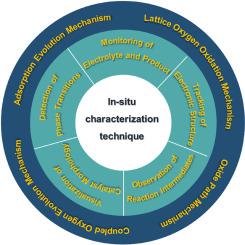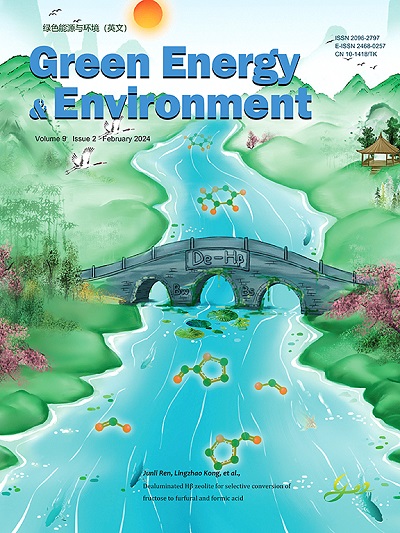电解水析氧原位研究进展与展望
IF 10.7
1区 工程技术
Q1 CHEMISTRY, PHYSICAL
引用次数: 0
摘要
电力驱动的水裂解制氢是缓解能源危机和环境污染的最有效途径之一,其中阳极析氧反应(OER)是水裂解中性能限制的关键半反应。考虑到实际工作条件下所涉及的催化剂的复杂反应过程和表面重构,通过原位表征技术和理论计算来揭示真实的活性位点,探测多种反应中间体和澄清催化途径至关重要。本文综述了近年来各种原位表征技术在理解水氧化过程、揭示水氧化活性相和阐明水氧化催化机理等方面的研究进展。首先,我们介绍了传统的OER催化机制和新的OER进化机制,并强调了最佳催化途径和内在稳定性的重要性。接下来,我们全面概述了原位表征技术的基本工作原理、不同的检测模式、适用场景和局限性。在此基础上,我们以原位研究为例,讨论了相变检测、物种演化可视化、电子结构跟踪、反应活性中间体观察、催化产物监测以及建立催化构效关系和催化机理。最后,简要地提出了水氧化过程的关键挑战和未来的展望。本文章由计算机程序翻译,如有差异,请以英文原文为准。

Recent Advances and Key Perspectives of In-Situ Studies for Oxygen Evolution Reaction in Water Electrolysis
Electricity-driven water splitting to produce hydrogen is one of the most efficient ways to alleviate energy crisis and environmental pollution problems, in which the anodic oxygen evolution reaction (OER) is the key half-reaction of performance-limiting in water splitting. Given the complicated reaction process and surface reconstruction of the involved catalysts under actual working conditions, unraveling the real active sites, probing multiple reaction intermediates and clarifying catalytic pathways through in-situ characterization techniques and theoretical calculations are essential. In this review, we summarize the recent advancements in understanding the catalytic process, unlocking the water oxidation active phase and elucidating catalytic mechanism of water oxidation by various in-situ characterization techniques. Firstly, we introduce conventionally proposed traditional catalytic mechanisms and novel evolutionary mechanisms of OER, and highlight the significance of optimal catalytic pathways and intrinsic stability. Next, we provide a comprehensive overview of the fundamental working principles, different detection modes, applicable scenarios, and limitations associated with the in-situ characterization techniques. Further, we exemplified the in-situ studies and discussed phase transition detection, visualization of speciation evolution, electronic structure tracking, observation of reaction active intermediates, and monitoring of catalytic products, as well as establishing catalytic structure-activity relationships and catalytic mechanism. Finally, the key challenges and future perspectives for demystifying the water oxidation process are briefly proposed.
求助全文
通过发布文献求助,成功后即可免费获取论文全文。
去求助
来源期刊

Green Energy & Environment
Energy-Renewable Energy, Sustainability and the Environment
CiteScore
16.80
自引率
3.80%
发文量
332
审稿时长
12 days
期刊介绍:
Green Energy & Environment (GEE) is an internationally recognized journal that undergoes a rigorous peer-review process. It focuses on interdisciplinary research related to green energy and the environment, covering a wide range of topics including biofuel and bioenergy, energy storage and networks, catalysis for sustainable processes, and materials for energy and the environment. GEE has a broad scope and encourages the submission of original and innovative research in both fundamental and engineering fields. Additionally, GEE serves as a platform for discussions, summaries, reviews, and previews of the impact of green energy on the eco-environment.
 求助内容:
求助内容: 应助结果提醒方式:
应助结果提醒方式:


